Explore Aosta – a Roman town at the foot of the Alps
About Aosta
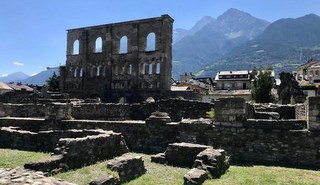
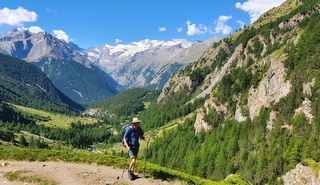
Aosta is a mountain town with over 2,000 years of history. It sits at 583 metres above sea level and is surrounded by magnificent alpine scenery, overlooked by some of Europe’s highest peaks: Mont Blanc, the Matterhorn, Monte Rosa and Gran Paradiso. It has an interesting cross-culture of French and Italian influences which come to light in the cuisine and in the local dialect. Although its roots are Roman, today it is a magnet for outdoor enthusiasts from around the world, for skiing in winter and mountaineering and hiking in summer. We pass through Aosta on our Best of the Italian Alps tour.
Where is Aosta?
Aosta is the main town in the region known as the Valle d’Aosta which is Italy’s smallest region and least populated. It is in the far north-west of the country, where Italy borders France. Aosta is the gateway to Italy for those arriving from France through the Mont Blanc tunnel or from Switzerland through the Great St Bernard tunnel. The Valle d’Aosta is one large glacial valley running east-west, and the town of Aosta sits in the middle of the valley floor, around 110 km from Turin to the south and 145 km from Geneva to the north.
History of Aosta
Originally the territory of a Celtic tribe known as the Salassi, the Valle d’Aosta was conquered by the Romans in the first century BC. They established the settlement known as Augusta Praetoria (Aosta), constructing an excellent example of an organised urban plan with a rectangular layout and four symmetrical paired gateways. After the fall of the Western Roman Empire in the 5th century, the Valle d’Aosta was ruled by the French, passing through many hands until it was annexed in the 11th century by the House of Savoy which was later to become the royal house of Italy. The autonomous region of Valle d’Aosta was created in 1945 and today the unique Valdostan culture still exists in the language and the cooking.
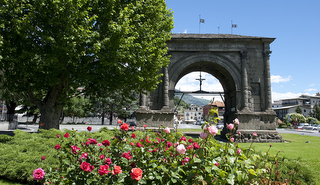
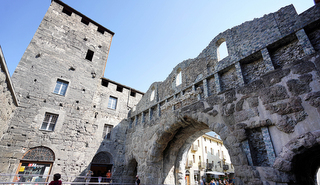
Things to do in Aosta
Roman Ruins
There are many vestiges of Roman architecture to explore. Start with the Augustus Arch, a triumphal structure dedicated to the Emperor Augustus. Cross the Buthier River to reach the cobbled Roman Bridge. Since its construction the river has changed its course, but the bridge is perfectly preserved and still in use today. The Porta Praetoria, one of the main gates into the original Roman city still stands, with its central opening for carriages, and two side openings for pedestrians. The Roman theatre, built in the 1st century AD , still has its southern facade visible, measuring an impressive 22 metres.
Medieval Churches
The Cattedrale Santa Maria Assunta has a wonderful Gothic interior and the carved walnut 15th century choir stalls are very beautiful. There are two mosaic floors which are also particularly striking. The Chiesa di Sant’Orso dates back to the 10th century, although it has been altered many times over the centuries. It sits alongside an ornate Romanesque cloister, part of the Sant’Orso complex, and has a 12th century bell tower.
Hiking and Mountain Biking
The Valle d’Aosta is a mecca for summer hikers and cycling enthusiasts. There are numerous hiking trails, recommended multi-day walks staying in huts, 1000 km of unsurfaced tracks which are perfect for mountain biking, and 21 routes on inland roads providing scenic and panoramic cycle rides. The choice of outdoor activities is endless, with rafting, canoeing, kayaking, canyoning and fishing all on offer in summer months, as well as horse-riding, golf and hot-air ballooning.
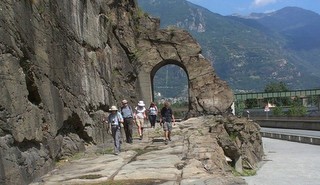
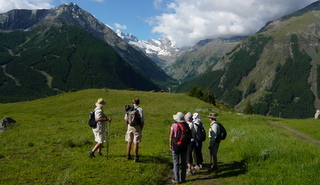
What to eat and drink in Aosta
In spite of the mountainous landscape around Aosta, the region is cultivated even at high altitudes. Charcuterie and cured meats are prevalent, and a preserved beef stew known as Carbonade is a local favourite. The other important ingredient in the region is cheese, with the local cattle enjoying the rich high alpine pastures in summer. Fontina is the king of Aosta cheeses, which is an excellent cooking and melting cheese, and can appear in anything from soups to pasta sauces. For those with a sweet tooth look out for the dessert named after the Montebianco – a rich swirl of chestnut puree and cream. The region grows good wild berries and pears which are usually served poached in red wine.
Compared to other regions of Italy, the Valle d’Aosta has small number of hectares of vines, but has become one of the fastest-developing wine producers in the country. White grapes to look out for include Prié Blanc, Müller-Thurgau, Pinot Grigio and Pinot Bianco, and reds include Fumin, Gamay, Nebbiolo and Pinot Nero.
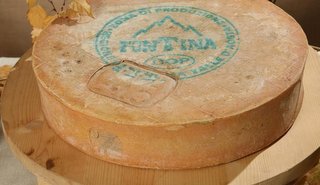
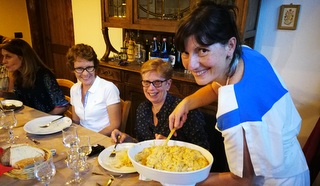
Getting to Aosta
The nearest airports for Aosta are Turin, Milan or Geneva. Aosta has a railway station with frequent services to the Turin stations of Porta Nuova and Porta Susa. Milan trains require a change at Ivrea and Chivasso. By road you can take the E25 motorway which follows the Aosta Valley all the way to Courmayeur. If you want to see Aosta in film then the series Ice Cold Murders: Rocco Schiavone is set here and often shows shots of the town. It is a character-driven, compelling Italian crime TV series about a cranky and unorthodox detective who is exiled from his beloved Rome to the snowbound Valle d’Aosta.
